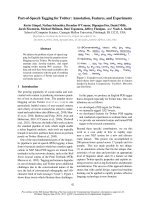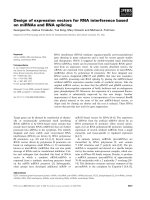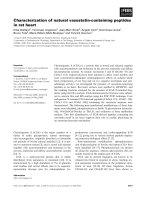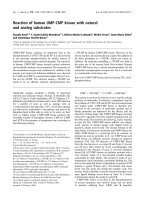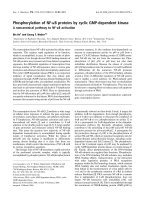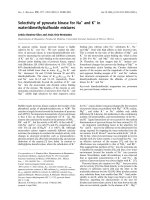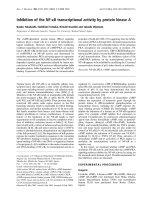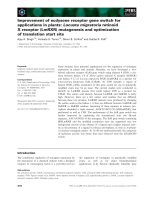báo cáo khoa học: " Improvement of primary care for patients with chronic heart failure: A study protocol for a cluster randomised trial comparing two strategies" pps
Bạn đang xem bản rút gọn của tài liệu. Xem và tải ngay bản đầy đủ của tài liệu tại đây (236.58 KB, 7 trang )
STUDY PROT O C O L Open Access
Improvement of primary care for patients with
chronic heart failure: A study protocol for a
cluster randomised trial comparing two strategies
Jan van Lieshout
1*
, Betty Steenkamer
2
, Marjan Knippenberg
1
and Michel Wensing
1
Abstract
Background: Many patients with chronic heart failure (CHF), a common condition with high morbidity and
mortality rates, receiv e treatment in primary care. To improve the management of CHF in primary care, we
developed an implementation programme comprised of educational and organisational components, with support
by a practice visitor and focus both on drug treatment and lifestyle advice, and on organisation of care within the
practice and collaboration with other healthcare providers. Tailoring has been shown to improve the success of
implementation programmes, but little is known about what would be best methods for tailoring, specifically with
respect to CHF in primary care.
Methods/design: We describe the study protocol of a cluster randomised controlled trial to examine the
effectiveness of tailoring a CHF implementation programme to general practices compared to a standardised way
of delivering a programme. The study population will consist of 60 general practitioners (GPs) and the CHF
patients they include. GPs are randomised in blocks of four, stratified according to practice size. With a tailored
implementation programme GPs prioritise the issues that will form the bases of the support for the practice visits.
These may comprise several issues, both educational and organizational.
The primary outcome measures are patient’s experience of receiving structured primary care for CHF (PACIC, a
questionnaire related to the Chronic Care Model), patients’ health-related utilities (EQ-5D), and drugs prescriptions
using the guideline adherence index. Patients being clustered in practices, multilevel regression analyses will be
used to explore the effect of practice size and type of intervention programme. In addition we will examine both
changes within groups and differences at follow-up between groups with respect to drug dosages and advice on
lifestyle issues. Furth ermore, in interviews the feasibility of the programme and goal attainment, organisational
changes in CHF care, and formalised cooperation with other disciplines will be assessed.
Discussion: In the tailoring of the programme we will present the GPs a list with barriers; GPs will assess relevance
and possibility to solve these barriers. The list is rigorously developed and tested in various projects. The factors for
ordering the barriers are related to the innovation, the healthcare professional, the patient, and the context.
CHF patients do not form a homogeneous group. Subgroup analyses will be performed based on the distinction
between systolic CHF and CHF with preserved left ventricular function (diastolic CHF).
Trial registration: ISRCTN: ISRCTN18812755
* Correspondence:
1
Scientific Institute for Quality of Healthcare, Radboud University Nijmegen
Medical Centre, P.O. Box 9101, 114 IQ Healthcare, 6500 HB Nijmegen, The
Netherlands
Full list of author information is available at the end of the article
van Lieshout et al. Implementation Science 2011, 6:28
/>Implementation
Science
© 2011 va n Lieshout et al; licensee BioMed Central Ltd. This is an Open Access article distributed under the terms of the Creative
Commons Attribution License ( 0), which permits unrestri cted use, distribution, and
reproduction in any medium, provided the origina l work is properly cited.
Background
Chronic heart failure (CHF) is a highly prevalent chronic
disease with high morbidity and mortality rates. The
prevalence of CHF in the Western world is 1% to 2% in
the general population and at least 10% among the age
group of 85 years and older [1,2]. Mortality in CHF
patients is high compared to their age group [2,3]. High
morbidity is associated with high hospital admission
rates and reduced quality of life [4]. There are effective,
evidence-based treatments which improve mortality and
morbidity but use of and adherence of treatments is
suboptimal despite clinical guidelines [5-9].
A large group of patients with CHF receive treatment
in primary care. There are many progra mmes for the
management of long-term conditions in primary care –
e.g., diabetes, COPD and depression – butatpresent
not for CHF, though several disease management pro-
grammes exist for CHF related to outpatient clinics. As
a substantial proportion of CHF patients do not attend
such clinics but visit their GP instead, these patients are
not enrolled in a structured care programme.
To improve the management of CHF in primary care,
we have developed an i mplementation programme,
comprising both educational and organisational compo-
nents, the latter aimed at improved and structur ed care.
We pilot tested this programme in 19 general practic es
[10]. The p ilot programme was targeted at implement-
ing the prevailing practi ce guideli ne for gene ral practice
[11]. In the mean time, in the Netherlands an interd isci-
plinary guideline on CHF, based on the European
Society of Cardiology (ESC) guideline, was developed
and published in May 2010 [12]. So, we adapted the
implementation programme according to this new
guideline, taking into account the lessons learned in the
pilot study.
Apartfromofferingastandard implementation pro-
gram me, another approach is to tailor an intervention to
the special needs and conditions in a general practice. Ide-
ally, tailoring has three components: identification of fac-
tors associated with implementation (or labelled as
‘barriers to change’), to match implementation interven-
tions to those factors, and evaluation of the tailored imple-
mentation programme. Tailoring has been shown to have
a modest effect on the success of the implementation pro-
gramme [13], but little is known about what would be best
methods for t ailoring [14]. In addition, research evidence
specifically supporting this hypothesis with respect to
improving primary care for CHF patients is not yet avail-
able. In one study no relation was found between barriers
perceived and ACE inhibitor prescription behaviour [15].
Earlier studies to improve CHF patients care focused on
disease management programmes, mainly case manage-
ment, and on education and drug prescription [16,17].
Patients being clustered in practices, we planned to
conduct a cluster randomised controlled trial with ran-
domisation at the practice level. The aim of the study
will be to examine the effectiveness of tailoring the
implementation programme to general practices com-
pared to a standardised way of delivering the implemen-
tation programme to general practices.
Methods
The project will be a collaborative project of IQ health-
care, a research department of Radboud University Nij-
megen Medical Centre, and the four regional supportive
structures for primary care (’ROS’) in the south of the
Netherlands and their cooperative bond Robuust. The
medical ethical committee (CMO Regio Arnhem –
Nijmegen) assessed the study proposal and waived
approval.
Participants
The study population will consist of 60 general practi-
tioners (GPs) and the CHF patients they will include.
GPs will be recruited in the south of the Netherlands,
contacted either direc tly or indirectly via various regio-
nal organisations by advisors of the regional supportive
structures for primary care. GPs will be informed about
the project, and when they agree to participate they will
be instructed to send in an admission form with data on
practice organization nece ssary for stratification and
randomization.
Evidence of change will be assessed by studying the
effects of the intervention on patients with CHF regis-
tered with the participating GPs. As in the pilot [10],
GPs will include all CHF patients from their practices
who are over 18 years of age of whom the GPs consider
themselves to be the physician taking care of the treat-
ment of this condition in the patient. We expect eight
to ten patien ts per practice [18,19]. Patients will be sent
explanation about the study and asked for informed
consent to participate in a patient questionnaire. Data
collection will be anonymized.
Interventions
Standardised delivery of the implementation programme
The implementation pack contains educational materials
for the professionals and patients. There is a recom-
mended protocol for multidisciplinary management and
a template for clinical care presented as a guiding regis-
tration form. Furthermore, we offer support by a visiting
practice consultant and the possibility to contact a GP
with a special interest in CHF management.
The project materials from the pilot were amended fol-
lowingthepilotstudyandthedevelopmentofthenew
interdisciplinary practice guideline [12]. Participating GPs
van Lieshout et al. Implementation Science 2011, 6:28
/>Page 2 of 7
will be informed about healthcare professionals from other
primary care disciplines, e.g., dieticians and physiothera-
pists, and these professionals will be informed about the
project, encouraging the role of the multidisciplinary team
in CHF management. The paragraph on non-pharmaceu-
tical treatment was enlarged and the pharmaceutical para-
graph had some changes. Now, recommendations on drug
treatment are different for patients with systolic CHF
compared to patients with a preserved systolic heart func-
tion, so called diastolic CHF (See Table 1). Finally, new
recommendations on the use of devices were formulated.
The paper template is used to direct care and collect
data to demonstrate the effectiveness of the interven-
tions. Demographic data is collected in particular the
aetiology of the CHF and the diagnostic category,
whether diagnosis w as echocardiography based, on the
existence of diastolic or systolic CHF, and pharmaceuti-
cal treatment at the start of the project period. A second
page poses questions about non-pharmaceutical issues
such as advice about physical activity and influenza vac-
cination. Finally, we offer different forms for patients
with systolic or diastolic CHF, based on the recommen-
dations on medication as summarised in Table 1.
The pilot study demonstrated that three practice visits
was the optimum number and these shall be offered to
all participating practices. The practice visitor is an edu-
cational facilitator trained in supporting behaviour
change in practices.
The pilot study also demonstrated that there was little
multidisciplinary clinical activity in the improvement of
care for CHF patients, and this has been addressed in this
project. We now use the multidisciplinary practice guide-
line as a starting point instead of the monodisciplinary
GP’s practice guideline. Furthermore, the regional advisors
will determine the social network in the practice area, pro-
viding information on other primary care disciplines, e.g.,
dieticians and physiotherapists, with extra expertise and
interest in CHF treatment. These workers in the other dis-
ciplines will be informed about the project and receive
relevant information in line with the multidisciplinary
guideline.
All materials are offered paper b ased in a binder. We
will also present all materials on a website and examine
the possibilities for designing the guiding p atient regis-
tration forms on this website as well.
Tailored delivery of the implementation intervention
The intervention group of practices will have the agenda
of their practice visits determined by the results of a
questionnaire identifying the barriers they perceive to
the introduction of a programme for the management
of CHF in primary care. The barriers listed in the ques-
tionnaire are based on previous research and grouped in
relation to the innovatio n, the healthcare professional,
the patient, and the context [20]. GPs are asked to indi-
cate the relevance of each barrier in their practice situa-
tion on a five-point scale, and whether or not they think
thatthebarriercanbesolved.Table2showssome
examples of barriers suggested in the format of the
questionnaire. GPs are offered the possibility to add bar-
riers they perceive that are not yet identified. When bar-
riers are iden tified, those that are relevant and solva ble
will be prioritised and addressed during the practice
visits.
Objectives
The objective of the study is to examine the effective-
ness of identifying barriers to change, and tailoring edu-
cation and support in comparison with a standard
intervention programme, to improve the management of
patients with CHFin primary care.
Our null hypothesis is that tailoring does not result in
better implementation of the guidelines for CHF com-
pared to a standardised delivery of our implementation
programme. In addition, we will also examine whether
either of the two programmes are associated with
improvements in healthcare delivery and patient
outcomes.
Measures
Data collection will comprise the f ollowing measures:
patient questionnaires, patient registration forms, and
telephone interviews with the GPs. Practices will send
out patient questionnaires based on validated and pre-
vious used questionnaires: PACIC [21], EQ-5D [22 ],
questions about ‘continuity of care,’ and Morisky’s ques-
tionnaire on medication adherence [23]. In the patient
Table 1 Changes in medication advice
Medication advice based on
the 2005 GP practice guideline
Medication advice based on the
2010 multidisciplinary guideline
One scheme: Systolic heart failure:
- Diuretics - ACE inhibitor (or ARB if not
tolerated) in evidence based
doses
- ACE inhibitors or ARB - Diuretics for fluid retention
- Beta blocker - Beta blocker blockers licensed
for heart failure in evidence
based doses
- Aldosteron antagonist - Aldosterone antagonist or ARB
- Digoxin - Digoxin or H + ISND
Diastolic heart failure:
- Diuretic if signs of fluid
retention
- Adequate treatment of co
morbidity
- Strict blood pressure control
ARB = angiote nsin II receptor blocker.
H + ISDN = Hydralazine + isosorbide dinitrate.
van Lieshout et al. Implementation Science 2011, 6:28
/>Page 3 of 7
registration forms, data about non-pharmaceutical and
drug therapy are registered by the GPs and their staff:
they register the baseline treatment at inclusion, and
during the patient contacts through out the study period
they register all advice given, referrals, drug therapy
changes, and information on hospitalisation and mortal-
ity. The GP interview will score goal attainment and a
qualitative assessment of the programme. All measures
have been applied by our group in previous studies.
Outcomes
The primary outcome measures are determined at the
patients’ level and consist of experience of receivi ng
structured primary care for CHF (PACIC) and health-
related utilities (EQ-5D), and of drug prescriptions.
PACIC is a questionnaire consisting of 27 items,
which is related to the Chronic Care Model [24]. We
translated and validated PACIC for use in general prac-
tice in the Netherlands [25]. EQ-5D consists of five
questions and a Visual Analogue Scale (VAS), which has
been validated for use in the Netherlands [26]. These
outcome measures reflect key aspects of medical treat-
ment, organization of care, and patient reported quality
of life, and were chosen pragmatically because of the
availability of relevant, validated, responsive, composite
measures.
Drug prescription scores are assessed using the guide-
line adherence index (GAI), indicating the proportion of
indicated drugs that is prescribed [27,28]. These include
ACE inhibitors and beta blockers, and – depending on
the patient’s CHF severity according to the NYHA
classes – further drug classes [12].
Secondary outcome measures at the patients’ level
concern lifestyle advice and medication during the study
period, based on the patient registration forms providing
information on non-pharmaceutical advice and drug
prescriptions, continuity of care, and medication adher-
ence. Considering drug therapy we will assess the per-
centages of ACE inhibitors and beta blockers prescribed
in the evidence-based target dosages. Secondary out-
come measures at the practice level are goal att ainment
and qua litative assessment of the programme, focus sing
onthesubjectiveGP’s experiences, for instance on
improvement of practice organisation a nd collaboration
with other primary care professionals.
Randomisation
The study will be a r andomised controlled trial, with a
one-year follow-up period. Practices are stratified
according to practice size as solo, duo, or group prac-
tice. On inclusion, practices are assigned to one of the
study groups using randomisation in blocks of four per
stratum by a research assistant. Blocks were generated
electronically with the help o f a statistician. The rando-
mising procedure i tself is concealed for practices, con-
sultants, and researchers (JvL, MW). The regional
Table 2 Examples of possible barriers as presented in the GP’s questionnaire for the tailored intervention
To what extend is this barrier
relevant for your practice
situation?
Do you consider it possible to
solve this barrier in your practice
situation?
1. Innovation
The recommendations in the multidisciplinary practice guideline
heart failure ask for changes in our existing practice routines that are
too big.
❑ Not at all
❑ A little
❑ Neutral
❑ Relevant
❑ Very relevant
❑ Yes
❑ No
❑ Doubtful
2. Health care professional
I lack sufficient knowledge of the recommendations in the
multidisciplinary practice guideline heart failure.
❑ Not at all
❑ A little
❑ Neutral
❑ Relevant
❑ Very relevant
❑ Yes
❑ No
❑ Doubtful
3. Patient
Considering patients with complex health issues all time reserved
usually is taken completely by the actual problems and we do not
manage to provide a more structured approach for the heart failure
problems.
❑ Not at all
❑ A little
❑ Neutral
❑ Relevant
❑ Very relevant
❑ Yes
❑ No
❑ Doubtful
4. Context
We lack sufficient supportive staff to provide care according to the
practice guideline.
❑ Not at all
❑ A little
❑ Neutral
❑ Relevant
❑ Very relevant
❑ Yes
❑ No
❑ Doubtful
van Lieshout et al. Implementation Science 2011, 6:28
/>Page 4 of 7
advisors including the practices have no access to the
randomisation process. After randomisation, both
the practice and the regional advisor are informed. The
intervention is open to all involved.
Data analysis
The primary analysis is a comparison of primary out-
comes at follow-up between the study groups, taking
into account clustering of patients within practices.
Multilevel regression analyses will be used to explore
theeffectofpracticesizeand type of intervention pro-
gramme.Inaddition,wewill examine both changes
within groups and differences at follow-up between
groups with respect to percentage of patients on the
maximum tolerated dosage of ACE inhibitor or angio-
tensin II receptor blocker and of beta blockage; medica-
tion completely according to the guideline; having
received influenza vaccination in the winter season
2010-2011; having received professionally guided
physical activity training; and the number of non-
pharmaceutical issues addressed. If possible, subgroup
analyses will comprise type of CHF (systolic or diastolic)
and diagnostic certainty (secondary care diagnosis,
echocardiography diagnosis) The interviews will be used
to assess the feasibility of the programme and goal
attainment, organisational chan ges in CHF care, and
formalised cooperation with other primary care dis-
ciplines and specialist care.
Sample size
Power calculations are based on the primary o utcome
measurement PACIC. The PACIC comprises 27 ques-
tions with an answering scale from 1 to 5. A previous
unreported study showed that its standard deviation was
1.0. To detect a differenc e of 0.3 points with a standard
deviation of 1 (a relatively small effect), with alpha =
0.05 and beta = 0.20, ICC = 0.05, a total of 51 practices
with 10 patients each would be required, or 59 practices
with 8 patients.
Time frame
Practice inclusion is planned from June until October
2010. After inclusion, practices participate in the pro-
gramme during one year. At the start of the year, the
GPs include all their patients with CHF they treat at
least in part themselves. During that year, patients with
newly diagnosed CHF can also be included. Data man-
agement in the patient registration forms is a continu-
ous process during the project year. After the project
period of a year, the forms are anonymised and sent to
the researchers coded. Furthermore, practices will send
coded patient questionnaires with explanation of the
survey and ask for an informed consent; these will be
returned to the researchers. Finally the r esearche rs will
contact the GPs participating for the telephone i nter-
view. The GPs will receive feedback based on the patient
registration forms and the questionnaires.
Discussion
There exist various classifications of barriers (and facilita-
tors) and multiple approaches for linking interventions to
barriers [29-31]. In their systematic review, Légaré and
colleagues propose a co nceptual framework with knowl-
edge, attitude, and behaviour as main factors [31]. Our
choice of barriers is based on a list rigorously developed
in the Netherlands with a literature study in 2002, expert
input, and tested in various projects in the Netherlands
[20]. Our main factors for ordering the barriers are
related to the innovation, the healthcare professional, the
patient, and the context. The barriers presented in this
study correspond very well to t he barriers found most
often in the Légaré review, including ti me pressure and
lack of applicability. Looking for the barriers for each
individual practice an d not for the pract ices participating
in general, we decided to have the barriers proposed
scored in email contact with the GPs in two rounds.
Several studies w ere conducted to assess the effect of
tailoring implementation. In a systematic review, the
authors conclude that identifying barriers and tailoring
intervention to these barriers may improve clinical prac-
tice compared to no intervention and to guideline disse-
mination. In their meta analysis including eight studies
identified with a non-tailored intervention in the control
group, they report a modest effect of tailoring [13].
All data collection will take place at the end of the
project period. Within the context of the evaluation of
the implementation project, it is not feasible to have
data collection both at the start and at the end, but the
patient registration form will have baseline data on
treatment issues. This also will allow for w ithin group
analyses, giving information about the effectiveness of
both implementation strategies separately. Unfortu-
nately, this data collection, either paper based or electro-
nically, will require additional administrative actions
from the practices. Enabling data collection from the
electronic medical record will be beyond the scope of
this project. Considering the patient questionnaire’s
results, with one measurement at the end, this restricts
us to intergroup analyses.
Our sample size is based on power calculation consid-
ering the PACIC outcomes. In previous research, a dif-
ference of 0.5 was found in the evaluation of a CHF and
a diabetes programme [32,33]. Thus, an effect size of 0.3
on PACIC can be considered a modest effect. We aim
at a lowered effect because we compare two strategies
that are both to be expected to have some impact.
Drug prescription is also a primary outcome measure.
We will present the GAI as a measure for the percentage
van Lieshout et al. Implementation Science 2011, 6:28
/>Page 5 of 7
of indicated drugs prescribed. In previous research, many
patients appeared to receive suboptimal dosages. When
considering ACE inhibitors and beta blockers, we will
report on the percentage of prescriptions in the indi-
cated, high-target dosages [34].
We decided to stratify practices include d based on
practice size. There is some evidence of a relation
between practice size and quality of care [35,37]. In one
study, larger practice size was associated with more
structured care [35]. Stratification of practices based on
practice size could be defined as the number of GPs in
the practice and based on patient list size. We choose a
stratification scheme based on the former, with the
strata solo, duo, and group practices, which appeared
feasible in previous research leading to strata of compar-
able size.
CHF patients do not form a homogeneous group;
apart from aetiology, we make a distinction between sys-
tolic CHF and CHF with preserved left ventricular func-
tion (diastolic CHF). In our study, both patient groups
maybeincluded,asthepracticeguidelinegivesrecom-
mendations for b oth the patients with and without left
ventricular systolic dysfunction. Subgroup analyses will
be performed.
Acknowledgements
We greatly acknowledge Robuust, bond of regional supportive organisations,
and the health insurance organisations CZ and VGZ for granting this project,
grant number E09EL20. Furthermore, we acknowledge the regional advisors,
paid by the regional supportive organisations, for their critical appraisal of all
the materials and steps in the project.
Author details
1
Scientific Institute for Qual ity of Healthcare, Radboud University Nijmegen
Medical Centre, P.O. Box 9101, 114 IQ Healthcare, 6500 HB Nijmegen, The
Netherlands.
2
Robuust, Le Sage ten Broeklaan 11, 5615 CP Eindhoven, The
Netherlands.
Authors’ contributions
JvL and MW designed the study; JvL drafted the materials concerning the
content; BS and MK made essential contributions to the design and the
devolvement of the materials and the practical implications. JvL drafted and
revised the manuscript; MW, BS, and MK commented it critically. All authors
approved the final version of the manuscript.
Competing interests
Michel Wensing is an Associate Editor of Imp lementation Science. All
decisions on this manuscript were made by another senior Editor. The
authors declare that they have no competing interests.
Received: 22 July 2010 Accepted: 25 March 2011
Published: 25 March 2011
References
1. Mosterd A, Hoes AW: Clinical epidemiology of heart failure. Heart 2007,
93:1137-1146.
2. Mosterd A, Hoes AW, de Bruyne MC, Deckers JW, Linker DT, Hofman A,
Grobbee DE: Prevalence of heart failure and left ventricular dysfunction
in the general population; The Rotterdam Study. Eur Heart J 1999,
20:447-455.
3. Hartfalen. Omvang van het probleem. Hoe vaak komt hartfalen voor en
hoeveel mensen sterven eraan. 2010 [ />gezondheid-en-ziekte/ziekten-en-aandoeningen/hartvaatstelsel/hartfalen/
cijfers-hartfalen-prevalentie-incidentie-en-sterfte-uit-de-vtv-2010/].
4. Hobbs FD, Kenkre JE, Roalfe AK, Davis RC, Hare R, Davies MK: Impact of
heart failure and left ventricular systolic dysfunction on quality of life: a
cross-sectional study comparing common chronic cardiac and medical
disorders and a representative adult population. Eur Heart J 2002,
23:1867-1876.
5. Task Force for Diagnosis and Treatment of Acute and Chronic Heart Failure
2008 of European Society of Cardiology, Dickstein K, Cohen-Solal A,
Filippatos G, McMurray JJ, Ponikowski P, Poole-Wilson PA, Strömberg A, van
Veldhuisen DJ, Atar D, Hoes AW, Keren A, Mebazaa A, Nieminen M,
Priori SG, Swedberg K, ESC Committee for Practice Guidelines, Vahanian A,
Camm J, De Caterina R, Dean V, Dickstein K, Filippatos G, Funck-Brentano C,
Hellemans I, Kristensen SD, McGregor K, Sechtem U, Silber S, Tendera M,
Widimsky P, Zamorano JL: ESC Guidelines for the diagnosis and
treatment of acute and chronic heart failure 2008: the Task Force for
the Diagnosis and Treatment of Acute and Chronic Heart Failure 2008
of the European Society of Cardiology. Developed in collaboration with
the Heart Failure Association of the ESC (HFA) and endorsed by the
European Society of Intensive Care Medicine (ESICM). Eur Heart J 2008,
29:2388-2442.
6. Hunt SA, Abraham WT, Chin MH, Feldman AM, Francis GS, Ganiats TG,
Jessup M, Konstam MA, Mancini DM, Michl K, Oates JA, Rahko PS, Silver MA,
Stevenson LW, Yancy CW, Antman EM, Smith SC Jr, Adams CD,
Anderson JL, Faxon DP, Fuster V, Halperin JL, Hiratzka LF, Jacobs AK,
Nishimura R, Ornato JP, Page RL, Riegel B, American College of Cardiology;
American Heart Association Task Force on Practice Guidelines; American
College of Chest Physicians; International Society for Heart and Lung
Transplantation; Heart Rhythm Society: ACC/AHA 2005 Guideline Update
for the Diagnosis and Management of Chronic Heart Failure in the
Adult: a report of the American College of Cardiology/American Heart
Association Task Force on Practice Guidelines (Writing Committee to
Update the 2001 Guidelines for the Evaluation and Management of
Heart Failure): developed in collaboration with the American College of
Chest Physicians and the International Society for Heart and Lung
Transplantation: endorsed by the Heart Rhythm Society. Circulation 2005,
20:e154-235.
7. Kasje WN, Denig P, Stewart RE, de Graeff PA, Haaijer-Ruskamp FM: An
educational programme for peer review groups to improve treatment of
chronic heart failure and diabetes mellitus type 2 in general practice. J
Eval Clin Pract 2006, 12:613-621.
8. Bongers FJ, Schellevis FG, Bakx C, van den Bosch WJ, van der Zee J:
Treatment of heart failure in Dutch general practice. BMC Fam Pract
2006, 7:40.
9. Majeed A, Williams J, de Lusignan S, Chan T: Management of heart failure
in primary care after implementation of the National Service Framework
for Coronary Heart Disease: a cross-sectional study. Public Health 2005,
119:105-111.
10. Van Lieshout J, Wensing M, Grol R: Improvement of primary care for
patients with chronic heart failure: a pilot study. BMC Health Serv Res
2010, 10:8.
11. Rutten FH, Walma EP, Kruizinga GI, Bakx HCA, Van Lieshout J: NHG-
Standaard Hartfalen, eerste herziening. Huisarts Wet. 2005, 48:64-76.
12. Hoes AW, Walma EP, Rutten FH, Twickler TB, Rohling R, Jansen RWMM,
Jaarsma T, Feenstra TL, Bouvy ML, Buskens E, De Graaff M, De Kok IHM,
Dijkgraaf R, Duin M, Fischer E, Flikweert S, Hammelburg R, Honig A, Hulzebos E,
In den Bosch HJH, Janssen-Boyne J, Koers H, Kortrijk M, Ninaber PA, Poot E,
Post PN, Rosenbrand CJGM, Schiffer AAJJ, Van Dijk JL, Van Dijk P, Van Erp J,
Van Erven L, Van Leen M, Van Lieshout J, Van Veldhuisen DJ, Weerts M,
Voors AA: Multidisciplinaire richtlijn Hartfalen. 2010 [ />Downloads/1081/rl_hartfalen_2010.pdf], Accessed 15-7-2010.
13. Baker R, Camosso-Stefinovic J, Gillies C, Shaw EJ, Cheater F, Flottorp S,
Robertson N: Tailored interventions to overcome identified barriers to
change: effects on professional practice and health care outcomes.
Cochrane Database of Systematic Reviews 2010, 3, Art. No.: CD005470.
14. Bosch M, van der Weijden T, Wensing M, Grol R:
Tailoring quality
improvement
interventions to identified barriers: a multiple case
analysis. J Eval Clin Pract 2007, 13:161-168.
15. Kasje WN, Denig P, de Graeff PA, Haaijer-Ruskamp FM: Perceived barriers
for treatment of chronic heart failure in general practice; are they
affecting performance? BMC Fam Pract 2005, 6:19.
van Lieshout et al. Implementation Science 2011, 6:28
/>Page 6 of 7
16. Taylor SJC, Bestall JC, Cotter S, Falshaw M, Hood SG, Parsons S, Wood L,
Underwood M: Clinical service organisation for heart failure. Cochrane
Database of Systematic Reviews 2005, 2, Art. No.: CD002752.
17. Jaarsma T, Strömberg A, De Geest S, Fridlund B, Heikkila J, Mårtensson J,
Moons P, Scholte op Reimer W, Smith K, Stewart S, Thompson DR: Heart
failure management programmes in Europe. Eur J Cardiovasc Nurs 2006,
5:197-205.
18. Bongers FJM, Bakx JC, Heesakkers WHJ, Van de Lisdonk EH: De patiënt met
hartfalen in de huisartspraktijk. Hart Bull 2003, 34 :4-7.
19. Bosch M, van der Weijden T, Grol R, Schers H, Akkermans R, Niessen L,
Wensing M: Structured chronic primary care and health-related quality
of life in chronic heart failure. BMC Health Serv Res 2009, 19:104.
20. Peters MAJ, Harmsen M, Laurant MGH, Wensing M: Room for
improvement? Barriers to and facilitators for improvement in patient
care. Nijmegen, Centre for Quality of Care Research (WOK); 2002 [http://
www.wokresearch.nl/UserFiles/Docs/product_112.pdf], Accessed 15-7-2010.
21. Patient Assessment of Care for Chronic Conditions (PACIC). 2010 [http://
www.improvingchroniccare.org].
22. EQ-5D. A standardised instrument for use as a measure of health
outcome. 2010 [ />23. Morisky DE, Green LW, Levine DM: Concurrent and predictive validity of a
self-reported measure of medication adherence. Med Care 1986, 24 :67-74.
24. Wagner EH, Austin BT, Von Korff M: Organizing care for patients with
chronic illness. Milb Quat 1996, 34:511-544.
25. Wensing M, Van Lieshout J, Jung HP, Hermsen J, Rosemann T: The Patients
Assessment Chronic Illness Care (PACIC) questionnaire in The
Netherlands: a validation study in rural general practice. BMC Health
Services Research 2008, 8:182.
26. Lamers LM, Stalmeier PF, McDonnell J, Krabbe PF, van Busschbach JJ:
Measuring the quality of life in economic evaluations: the Dutch EQ-5D
tariff. Ned Tijdschr Geneeskd 2005, 149:1574-1578.
27. Oertle M, Bal R: Understanding non-adherence in chronic heart failure: a
mixed-method case study. Qual Saf Health Care 2010, 19:e37.
28. Komajda M, Lapuerta P, Hermans N, Gonzalez-Juanatey JR, van
Veldhuisen DJ, Erdmann E, Tavazzi L, Poole-Wilson P, Le Pen C: Adherence
to guidelines is a predictor of outcome in chronic heart failure: the
MAHLER survey. Eur Heart J 2005, 26:1653-1659.
29. Cabana MD, Rand CS, Powe NR, Wu AW, Wilson MH, Abboud PA, Rubin HR:
Why don’t physicians follow clinical practice guidelines? A framework
for improvement. J Am Med Assoc 1999, 282:1458-1465.
30. Espeland AA, Baerheim AA: Factors affecting general practitioners’
decisions about plain radiography for back pain: implications for
classification of guideline barriers–
a qualitative study. BMC Health Serv
Res 2003, 3:8.
31. Légaré F, Ratté S, Gravel K, Graham ID: Barriers and facilitators to
implementing shared decision-making in clinical practice: update of a
systematic review of health professionals’ perceptions. Patient Educ
Couns 2008, 73:526-535.
32. Peters-Klimm F, Campbell S, Hermann K, Kunz CU, Müller-Tasch T,
Szecsenyi J: Case management for patients with chronic systolic heart
failure in primary care: the HICMan exploratory randomised controlled
trial. Competence Network Heart Failure. Trials 2010, 17:56.
33. Schillinger D, Handley M, Wang F, Hammer H: Effects of self-management
support on structure, process, and outcomes among vulnerable patients
with diabetes: a three-arm practical clinical trial. Diabetes Care 2009,
32:559-566.
34. Bosch M, Wensing M, Bakx JC, van der Weijden T, Hoes AW, Grol RP:
Current treatment of chronic heart failure in primary care; still room for
improvement. J Eval Clin Pract 2010, 16:644-650.
35. Wensing M, van den Hombergh P, Akkermans R, van Doremalen J, Grol R:
Physician workload in primary care: what is the optimal size of
practices? A cross-sectional study. Health Policy 2006, 77:260-267.
36. Morgan CL, Beerstecher HJ: Practice size and service provision in primary
care: an observational study. Br J Gen Pract 2009, 59:e71-77.
37. Campbell SM, Hann M, Hacker J, Burns C, Oliver D, Thapar A, Mead N,
Safran DG, Roland MO: Identifying predictors of high quality care in
English general practice: observational study. BMJ 2001, 323:784-787.
doi:10.1186/1748-5908-6-28
Cite this article as: van Lieshout et al.: Improvement of primary care for
patients with chronic heart failure: A study protocol for a cluster
randomised trial comparing two strategies. Implementation Science 2011
6:28.
Submit your next manuscript to BioMed Central
and take full advantage of:
• Convenient online submission
• Thorough peer review
• No space constraints or color figure charges
• Immediate publication on acceptance
• Inclusion in PubMed, CAS, Scopus and Google Scholar
• Research which is freely available for redistribution
Submit your manuscript at
www.biomedcentral.com/submit
van Lieshout et al. Implementation Science 2011, 6:28
/>Page 7 of 7

